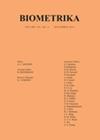更有效的精确群不变性测试:使用代表子群
IF 2.8
2区 数学
Q2 BIOLOGY
引用次数: 0
摘要
我们考虑在置换或符号翻转等变换的代数群下检验分布的不变性。由于这样的组通常是巨大的,基于整个组的测试通常在计算上是不可行的。因此,使用转换的随机子集是标准实践。我们通过用策略选择的固定变换子群替换随机子集来改进这一点。在广义的位置模型中,我们表明,在较低的信噪比下,结果测试通常是一致的。此外,我们建立了功率改进与正态性下从t检验切换到z检验之间的类比。重要的是,在基于排列的多重测试中,使用我们的方法可以获得巨大的效率增益,因为我们可以用更少的排列获得相同的功率。本文章由计算机程序翻译,如有差异,请以英文原文为准。
More Efficient Exact Group Invariance Testing: using a Representative Subgroup
We consider testing invariance of a distribution under an algebraic group of transformations, such as permutations or sign-flips. As such groups are typically huge, tests based on the full group are often computationally infeasible. Hence, it is standard practice to use a random subset of transformations. We improve upon this by replacing the random subset with a strategically chosen, fixed subgroup of transformations. In a generalized location model, we show that the resulting tests are often consistent for lower signal-to-noise ratios. Moreover, we establish an analogy between the power improvement and switching from a t-test to a Z-test under normality. Importantly, in permutation-based multiple testing, the efficiency gain with our approach can be huge, since we attain the same power with much fewer permutations.
求助全文
通过发布文献求助,成功后即可免费获取论文全文。
去求助
来源期刊

Biometrika
生物-生物学
CiteScore
5.50
自引率
3.70%
发文量
56
审稿时长
6-12 weeks
期刊介绍:
Biometrika is primarily a journal of statistics in which emphasis is placed on papers containing original theoretical contributions of direct or potential value in applications. From time to time, papers in bordering fields are also published.
 求助内容:
求助内容: 应助结果提醒方式:
应助结果提醒方式:


